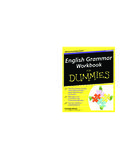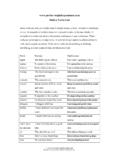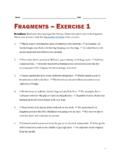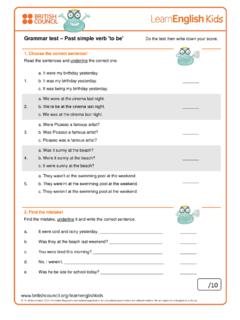Transcription of Grammar - anacereddine.com
1 Grammar Exercises Cross-reference to Arabic Grammar for the Exercises Essentials of Arabic Grammar Excerpts from The Textbook Abdallah Nacereddine. A New Approach to Teaching Arabic Grammar . Bloomington, IN: AuthorHouse, 2009. Copyright 2010 Abdallah Nacereddine Quit Contents (1) * ( ) . Subject P . 1. Separate personal pronouns 1 ( . 2. Affixed personal pronouns 2 ( . 3. Perfect 4 ( . 4. Imperfect 6 ( . 5. Imperative 8 ( . 6. Subject 9 ( . 7. Direct object 9 ( . 8. Indirect object 9 ( . 9. Annexation 13 ( . 10. demonstrative pronouns 15 ( . 11. Relative pronouns 18 ( . 12. Subjonctive 21 ( . 13. Jussive 21 ( . 14. Inna' and its sisters 28 ( . 15. Kana' and its sisters 31 ( . 16. Cardinal numbers 34 ( . 17. Ordinal numbers 43 ( . 18. Agreement of the adjective 46 ( . i Contents (2) * ( ) . 19. Elative 48 (.)))))))))))))))))))
2 20. Agreement of the verb 51 ( . 21. The five nouns 52 ( . 22. Adverb of time 53 ( . 23. Adverb of place 53 ( . 24. Adverb of state 54 ( . 25. Specificative 56 ( . 26. Active participle 58 ( . 27. Passive participle 59 ( . 28. Noun of instrument 60 ( . 29. Diptote 61 ( . 30. Complement of cause 65 ( . 31. Absoltue object 66 ( . 32. Concomitate object 67 ( . 33. Vocative 68 ( . 34. Exception 70 ( . 35. la' that denies the whole genus 71 ( . 36: Excalamative 72 ( . 37. Abbreviated 73 ( . ii Contents (3) * ( ) . 38. Defective 73 ( . 39. Prolonged 73 ( . 40. Spacification 76 ( . 41. Noun of place 77 ( . 42. Noun of time 77 ( . 43. Nomina vicis 79 ( . 44. Noun of manner 80 ( . 45. Connected adjective 81 ( . 46. Use of Masdar' (verbal noun) 83 ( . 47. Use of kullu' 86 ( . 48. Use of kila' and kilta' 88 ( . 49. Use of ba'dhun' 89 (.))))))))))))))))))))))))))))))
3 50. Use of ahadu' and ihda' 91 ( . 51. Use of nafsu' 93 ( . 52. Use of kathirun' and qalilun' 94 ( . 53. Writing of hamza 95 ( . 54. Time 98 ( . 55. Id>| and Miscellanesous 99 ( . iii 1. NOMINATIVE SEPARATE. PERSONAL PRONOUNS. ( . The following table gives the nominative separate personal pronouns. 3rd person 2nd person 1st person he you ( ) I . she you ( ) we . they (d.) you (d.) . they ( ) you ( ) . they ( ) you ( ) . Back to the Exercise Contents 1. 2. AFFIXED. PERSONAL PRONOUNS. ( . The following table gives the accusative, dative and genitive affixed personal pronouns. 3rd person 2nd person 1st person s. (1) . p.. d. d.. (1) affixed to a noun; affixed to a verb (See page 32). Back to the Exercise Contents 2. 2. THE USE OF THE AFFIXED . PERSONAL PRONOUNS . ( . The affixed personal pronouns can be used as.)))))))))
4 Personal . pronoun Indirect Direct Possessive Pronoun . object object . 1P. s.. 3 . 2 1 .. p.. 2P.. d.. 3P.. d.. (1) My teacher - (2) He understands me - (3) He speaks with me.. Back to the Exercise . Contents . 3 . 3. THE PERFECT. ( . The Perfect stem is obtained by cutting the last vowel of the third singular masculine perfect, and the perfect is conjugated by adding to this stem the following endings: 3rd person 2nd person 1st person s.. p.. d.. Back to the Exercise Contents 4. 3. Conjugation of the verb to write . in the perfect . ( . ) (1 . 1P. s.. p.. 2P.. d.. 3P.. (1) The vowel of the last radical and the suffix.. Remark: The perfect has only a suffix; it does not have a prefix.. Back to the Exercise . Contents . 5 . 4. THE IMPERFECT. ( . Whereas in the perfect, the different persons are expressed by suf- fixes, the Imperfect has prefixes.)))
5 It also has some suffixes to denote number and gender as shown below: 3rd person 2nd person 1st person s.. p.. d.. Back to the Exercise Contents 6. 4. Conjugation of the verb to write . in the imperfect . ( . ) (2 ) (1 . 1P. s.. p.. 2P.. d.. 3P.. (1) The prefix.. (2) The vowel of the last radical and the suffix.. Remark: The singular and the first person of the plural have no . suffix.. Back to the Exercise . Contents . 7 . 5. THE IMPERATIVE. ( . The imperative is formed from the jussive (Chap. 62) but, since it begins with two consonants, it takes a short prosthetic vowel. In the trilit- eral verb, the prosthetic "alif "alif, when the second radical takes fath>a or kasra, the vowrl is kasra, when it takes d>amma, it is d>amma, as the following table shows: 2nd person (3) (2) (1) .. d.. (3) to write (2) to sit (1) to open Back to the Exercise Contents 8.))
6 6-7-8. THE CASES OR DECLENSION OF. NOUNS (Subjet, Direct and Indirec objects). ( - - . There are three cases in Arabic and these are indicated merely by changing the vowelling of the final consonant (except in the dual and sound masculine plural endings). They are: a) The nominative case vowelled with d>amma , a student. the student. b) The accusative case vowelled with fath>a , a student. the student. (Note that tanwi\n is supported by alif, thus .). c) The dative and genitive cases vowelled with kasra with a student. with the student. the student's book. Back to the Exercise Contents 9. 6-7-8. THE DECLENSION OF THE DUAL. ( - - . The dual declines as follows: a) in the nominative case, the twins resemble one another. b) in the oblique cases, I know the twins. I speak with the twins. this is the twins' room.
7 Note that when the dual is annexated, both the article and . disappear, they are the pupil's parents. I know the pupil's parents. he loves his parents. Back to the Exercise Contents 10. 6-7-8. THE DECLENSION OF THE. SOUND MASCULINE PLURAL. ( - - . The Sound Masculine Plural declines as follows, and takes a) in the nominative case, the teachers write. b) in the oblique cases, I know the teachers. I speak with the teachers. this is the teachers' room. Note that when the sound masculine plural is annexated, both the article and disappear, they are Arabic teachers. I know the Arabic teachers. we like our teachers. Back to the Exercise Contents 11. 6-7-8. THE DECLENSION OF THE. SOUND FEMININE PLURAL. ( - - . The Sound Feminine Plural declines as follows, and takes: a) in the nominative case, the teachers (f.) write.
8 B) in the obliques cases, I know the teachers (f.). I speak with the teachers (f.). this is the teachers' room (f.). Remember: The sound feminine plural never takes fatha. It takes d>amma only in the nominative case, and kasra in the oblique cases, accusative, dative and genitive. Back to the Exercise Contents 12. 9. ANNEXATION. ( . A noun followed by another noun in annexation, in other words, when a noun is annexated to another noun, or pronoun, it automatically loses its tanwi\n or its in the dual and in the sound masculine plural, and being determined by annexation, it naturally loses its , the student's book, or his book (lit. the book of his). The following noun, or the second term of the annexation, the following genitive, may have the tanwi\n or be prefixed with the article . according to whether it is definite or indefinite, unless it is, itself, annexat- ed to another noun or pronoun.
9 However, it always terminates in kasra, it takes the genitive case, which is shown by kasra , the book of a student. the book of the student. Back to the Exercise Contents 13. 9. ANNEXATION (2). ( ) ( . the book of the Arabic language student. the book of your student. It is the rule of "Id>. Id>a\fa (annexation) that nothing must interpose be- tween the noun and its following genitive. Consequently, if the noun is qualified by an adjective, demonstrated by a demonstrative, or numbered by a number, the latter, the adjec- tive, the demonstrative and the number must come after the genitive, the new Arabic teacher. this Arabic teacher. the three Arabic teachers. Back to the Exercise Contents 14. 10. DEMONSTRATIVE PRONOUNS. ( . The Demonstrative pronouns are as follows: Close Distant , all cases .. , nom.. acc.))
10 And gen.. , all cases . , nom.. acc. and gen.. p. (m. and f.), all cases . 1) If the demonstrative qualifies a simple noun, it pre- cedes it, and the noun takes the article, this book. But if the noun is defined by a following genitive or a pro- nominal suffix, the demonstrative is placed after these, Back to the Exercise Contents 15. 10. DEMONSTRATIVE PRONOUNS (2). ( ) ( . this book of the teacher. this book of yours. 2) If the demonstrative is used pronominally and as a subject of a nominal sentence, then: a) If the predicate is an indefinite noun, no copula is necessary, this is a book. b) If the predicate is defined by the article, the third person is used as a copula to prevent the demonstrative from being taken adjectivally (as in 1), this is the boy. c) If the predicate is defined by a following genitive or a pronominal suffix, the demonstrative is put first, and no copula is needed, this is the teacher's book.






